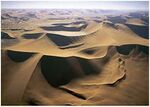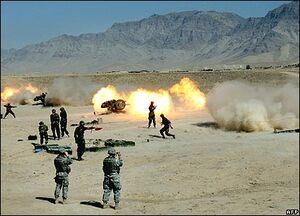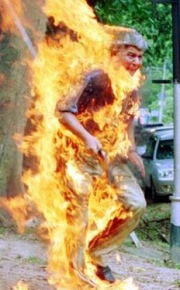Desert
Desert (not to be confused with "dessert", an after-meal treat, or "to desert", to go AWOL) is a happy, occupiable land infrequently occupied by those unfamiliar with the word "unoccupiable". It is formally defined as a region that receives no more than 5 ml of rainfall per millennia; however, if you wait a couple million years, eventually plate tectonics will make it so that desert will be at the bottom of the ocean, so just be patient. To keep the desert watered, many countries send their young to bleed to death there in holy and resource wars. Contrary to common misconception, deserts are not always sandy: many deserts are dry plains that people use to set records in weird cars, scrub-covered wastes, or frigid tundra covered in scurf. However, since at least 110% of the world's desert regions are of the sandy variety (known as "Sam" to experts), they are easily the most familiar to laypersons. Deserts have a reputation for being relatively lifeless, but a closer look at their natural ecology reveals, on average, that sun stroke can make a person hallucinate some of the most diverse zoology on Earth.
Biggest deserts[edit]
- Mahktesh Gadol, an erosional basin in the Negev Desert of southern Israel.
- The Mojave Desert in southeastern California
- Hell (not to be confused with Death Valley, or North Dakota)
A desert is a hostile, potentially deadly environment for unprepared humans. In hot deserts, high temperatures cause rapid loss of water due to sweating, and the absence of water sources with which to replenish it can result in dehydration and death within a few days. In addition, unprotected humans are also at risk from heatstroke.
Humans may also have to adapt to sandstorms in some deserts, not just in their adverse effects on respiratory systems and eyes, but also in their potentially harmful effects on equipment such as filters, vehicles and communication equipment. Sandstorms can last for hours, sometimes even days. This makes surviving in the desert quite difficult for humans, except for maybe mummies.
Despite this, some cultures have made hot deserts their home for thousands of years, including the Bedouin, Tuareg tribe and Pueblo people. Modern technology, including advanced irrigation systems, desalinization and air conditioning have made deserts much more hospitable. In the United States and Israel for example, desert farming has found extensive use.
In cold deserts, hypothermia and frostbite are the chief hazards, as well as dehydration in the absence of a source of heat to melt ice for drinking. Falling through pack-ice or surface ice layers into freezing water is a particular danger requiring emergency action to prevent rapid hypothermia. Starvation is also a hazard; in low temperatures the body requires much more food energy to maintain body heat and to move. As with hot deserts, some people such as the Inuit have adapted to the harsh conditions of cold deserts.
Most traditional human life in deserts is nomadic. It depends in hot deserts on finding water, and on following infrequent rains to obtain grazing for livestock. In cold deserts, it depends on finding good hunting and fishing grounds, on sheltering from blizzards and winter extremes, and on storing enough food for winter. Permanent settlement in both kinds of deserts requires regular water, food sources and adequate shelter, or the technology and energy sources to provide it.
Many deserts are flat and featureless, lacking landmarks, or composed of repeating landforms such as sand dunes or the jumbled ice-fields of glaciers. Advanced skills or devices are required to navigate through such landscapes and inexperienced travellers may perish when supplies run out after becoming lost. In addition sandstorms or blizzards may cause disorientation in severely reduced visibility.
The danger represented by wild animals in deserts has been featured in explorers' accounts but does not cause higher rates of death than in other environments such as rain forests or savanna woodland, and generally does not by itself affect human (mainly Middle Eastern, Southwest North American,North West North America, Northern African, Southern African, Northwest Chinese, Central Australian, and Polar distribution.) Defence against polar bears may be advisable in some areas of the Arctic, as may precautions against venomous snakes and scorpions in choosing sites at which to camp in some hot deserts.
The Mojave Desert is particularly dangerous; patrolling it almost makes one wish for a Nuclear Winter. Remember to bring an umbrella to provide yourself some shade, preferably one with solar panels on top for powering a mini fridge. Sand for creating glass reflective mirrors is plentiful, making heat rays as common as lasers are on Tatooine, it's a great way to fry scorpion meat, the lobster of the land, as well as your enemies, like ants.
Nevada Desert[edit]
A large and famous desert in North America is the Nevada Desert. This colossal, barren wasteland was first colonized by intrepid mafia explorers in search of a lost city of gold which they discovered in the form of the world's largest casino, part of an international trade hub known as the strip, The Polyester Road, featuring numerous UNESCO World Heritage Sites of priceless archaeological value, such as the ancient Egyptian pyramid the Luxor, and one of Cesar's North American palaces.
To this day, apart from Las Vegas, the only living creatures in the Nevada Desert are Lawyers, a blood-sucking reptilian species that cannot come out of their desert burrows in broad sunlight.
Desserts[edit]
Since the technical definition of a desert is an area with low annual rainfall, and since flavored ice is a type of dessert, it may be presumed that Antarctica could qualify as both a desert and a dessert, were it injected with red drink. Sand cones proved to be far less popular.
This, however, is impossible, because the amount of sugar required to dessertify the Ross Ice Shelf alone would exceed the total amount of produced in the history of the planet. Also, as desert expert and Baskin-Robbins owner Uncle Cracker says in his book on the subject, Antarctica: Desert, or Future Sno-Cone?: "Just think of the brain freeze you'd get from that!"
A few wackos have suggested that if a grape-flavored southern ice cap were to enlist and then go AWOL, that it would be a "dessert desert that's deserted". However, such people may be disregarded, as that's obviously too much of a stretch for the pun, and continents are barred from enlisting anyway.
Just Desert[edit]
The most fairminded barren wasteland is the Great American Desert. This desert even had it's own law (the Law of the West) which the other deserts were jealous of. This let to the Great Smearing in which all the unjust deserts accused the Great American Desert of not actually being a desert. Sadly, due to a UN resolution and widespread bribery, the Great American Desert's desert status was revoked and it was forced to become the agricultural capitol of the country.
Formation of a Desert[edit]
See Sand volcano
Record temperatures[edit]
The highest record temperature for this desert is 527.343 degrees celius. This is where most of the pie cooking company is located due to its extremely high temperature. The lowest temperature recorded is 527.344 degrees celcius. Many humans die due to frostbite due to this outrageously cold weather.


